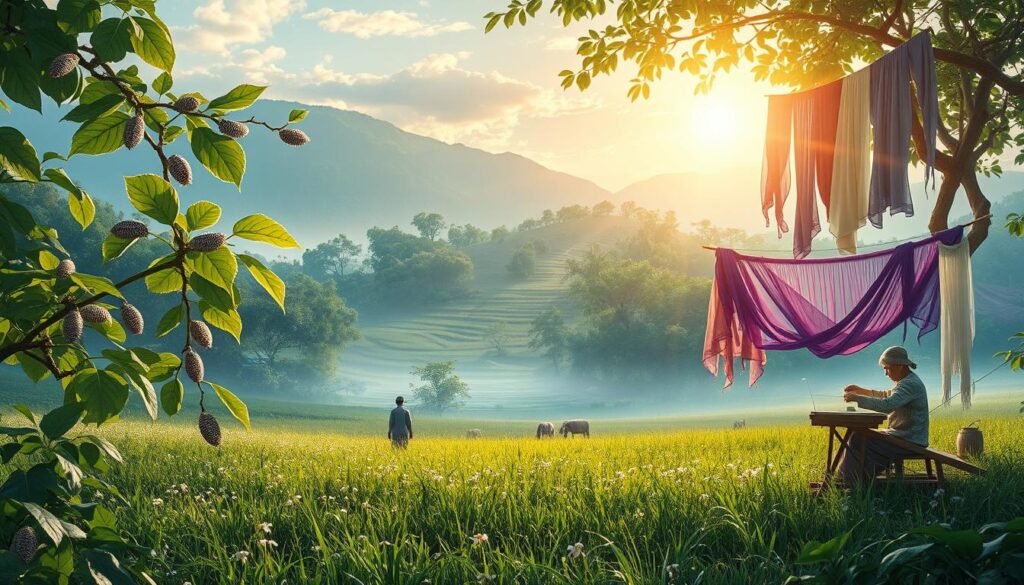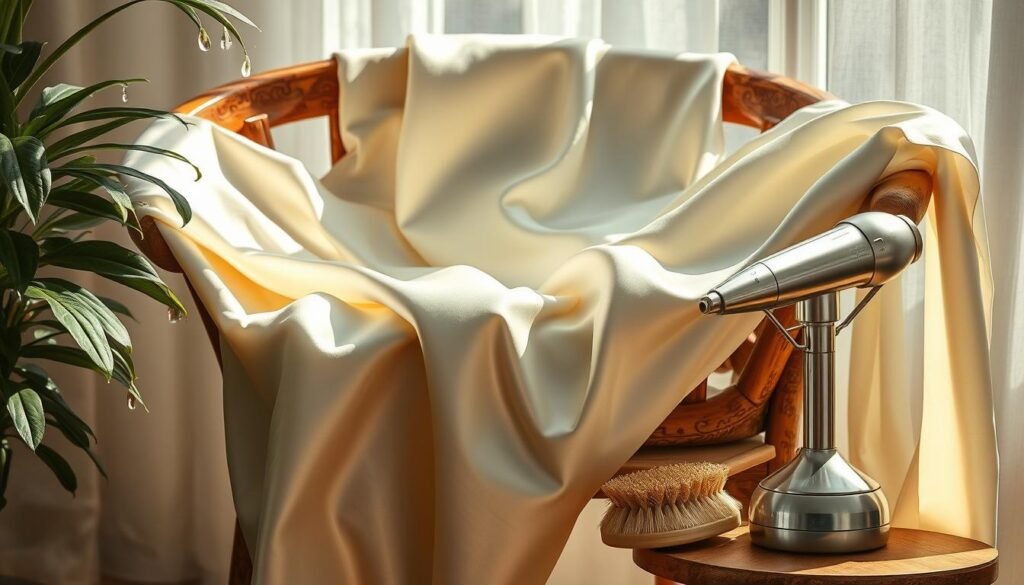Ever wondered why silk fabric shines and feels so soft? It’s all thanks to its natural makeup. Silk fabric comes from a protein fiber called fibroin. This is made by insects like the Bombyx mori silkworm to build their cocoons1.
Silk started in ancient China and was a secret for a long time. It spread to Asia and then the West. Now, people love silk for its softness, strength, and shine. This shine comes from the way the silk fibers reflect light1.
So, what makes silk so unique? Let’s explore its makeup and features more.
Key Takeaways
- Silk fabric is made of natural protein fibers called fibroin, produced by silkworms.
- Mulberry silk, the most common type, comes from silkworms eating mulberry leaves. This makes the threads smooth and fine1.
- Tussar silk, or wild silk, gets its unique feel from silkworms eating different trees. It’s a bit rougher1.
- Silk is hypoallergenic, keeps moisture away, and insulates well. This makes it a versatile and comfy fabric1.
- It’s important to take good care of silk clothes to keep them looking great1.
Introduction to Silk Fabric
Silk is a natural, luxurious fabric that has been loved for thousands of years. It started in ancient China, with the first use around 3630 BC2. Legend says Empress Leizu made sericulture, the art of making silk2.
This fabric spread through trade and became a luxury in Asia, the Middle East, Europe, and North Africa.
Origins and History of Silk
The Silk Road trade route helped share silk and other goods between cultures, changing the world2. Silk showed wealth and status, first for Chinese emperors, then for others2. China kept a monopoly on silk for a thousand years until the Silk Road opened up2.
Significance of Silk Throughout the Ages
Silk became a luxury fabric fast because of its unique feel and shine2. From 1850 to 1930, Japan and China led in silk exports, with Japan’s silk growing a lot2. But, the Japanese silk industry fell during World War II due to trade bans, leading to synthetic materials like Nylon2.
Now, silk is still a top fabric, with China making the most, followed by India3. Uzbekistan and Thailand are also big producers3. Silk’s strength, shine, and flow make it popular in fashion, design, and textiles.
| Country | Silk Production (Metric Tonnes) |
|---|---|
| China | 146,0003 |
| India | 28,7083 |
| Uzbekistan | Rank 33 |
| Thailand | Rank 43 |
Silk’s long history and importance in many cultures and industries make it interesting and valuable32.
Composition and Characteristics of Silk
Silk comes from the cocoons of silkworms, like the Bombyx mori4. Its fibers have a special shape that makes them shine and feel soft4. Raw silk has two smooth rods that look like triangles, making it look and feel luxurious4.
The Protein Fibers of Silk
Silk is made of a protein called fibroin from silkworms4. This makes silk strong and long-lasting, as strong as some man-made fabrics4. It also keeps its shape well if you take good care of it4.
Properties of Silk Fabric
Silk is light and lets air through, which helps keep you cool or warm4. It dries fast, making it easy to use every day and clean4. Silk looks smooth and shiny because of its straight fibers4.
There are many types of silk fabrics, each with its own look and use4. You can find chiffon, crêpe de chine, and others, all loved for their luxury and flexibility4.
“Silk is one of the most coveted and luxurious fabrics in the world, prized for its exceptional strength, softness, and sheen.”
Silk Production Process
The silk production starts with the amazing silkworm. These creatures go through a fascinating life cycle. They make the luxurious fabric we love5. Female silkmoths lay 300 – 500 eggs at once5. The silkworms grow up to 3 inches in about 6 weeks5.
They spin their cocoons in 3 to 8 days. This process involves about 300,000 movements5.
Life Cycle of the Silkworm
The silkworm’s life cycle is amazing. It’s this cycle that gives us the shiny silk we love6. Silk is made of natural protein fibers called fibroin6. Silkworms are fed mulberry leaves to make this special material6.
Reeling and Weaving Silk
After the silkworms spin their cocoons, the next step is to unwind the silk fibers5. It takes about 2,500 silkworms to make one pound of raw silk5. The silk strands are twisted together to make silk yarn.
Then, this yarn is woven into the luxurious silk fabric. There are different techniques like plain weave, satin weave, and twill weave used6. Mulberry silk, Tussar silk, Charmeuse silk, and Dupioni silk are some types of silk made this way6.

The silk production shows the skill and hard work of silkworms and artisans. From the silkworm’s life cycle to the careful reeling and weaving, making silk is a wonder of nature and human skill.
Types of Silk Fabric
Silk is a luxurious fabric with many types, each with special features and uses7. Mulberry silk is the most common type, but others have their own unique qualities.
Eri silk, also called “peace silk,” has a creamy-white color and a soft feel8. Tasar silk has a deep golden color and a warm texture, perfect for light clothes9. Muga silk comes from Assam, India, and has a golden-yellow color and a shiny look, great for special events.
Silk can be mixed with other fibers like spider silk, sea silk, and coan silk7. Spider silk is strong and stretchy. Sea silk is rare and has a soft, shiny look.
From sheer chiffon to stiff damask, silk fabrics offer many textures and colors9. These types let designers and fashion lovers make many items, from flowing dresses to fancy home decor, each with its own style.
What Is Silk Fabric Made Of? A Look at Its Composition
Silk fabric is a luxury item known for its quality, softness, and shine. But what makes it special? Silk is mainly made of a protein fiber called fibroin. This comes from the silkworms of the Bombyx mori species10.
The special shape of silk fibers gives it a shimmering look. This shape also makes it strong and durable10.
To make silk, silkworm cocoons are harvested and the silk fibers are unwound. Then, these fibers are twisted and woven into the final silk fabric. This hard work makes silk very valuable10.
| Silk Fabric Type | Characteristics |
|---|---|
| Mulberry Silk | The most common and widely used type of silk, known for its soft and smooth texture10. |
| Tussar Silk | Also known as wild silk, has a slightly rougher feel compared to mulberry silk10. |
| Charmeuse Silk | Renowned for its sensual allure, often used in luxurious evening gowns and lingerie10. |
| Dupioni Silk | Characterized by its slubbed texture, favored for its unique aesthetic10. |
Silk is not just beautiful but also has many benefits. It’s good for people with sensitive skin or allergies10. Silk keeps the body dry and controls temperature well, making it good for any season10.
Also, silk can reduce the look of fine lines and wrinkles. This makes it a top choice for fancy clothes, accessories, and home decor10.
Uses of Silk Fabric
Silk in Fashion and Apparel
Silk is a top choice in fashion for its softness and luxury. It’s used in dresses, blouses, scarves, and ties. It makes any outfit look fancy11. Mulberry silk is the most common type, known for its smoothness11. Tussar silk has a unique texture and is also popular. Charmeuse silk is great for evening wear because of its glossy and matte sides11. Dupioni silk is chosen for formal wear and home decor because of its special texture11.
Silk in Home Decor
Silk is also popular in home decor for its elegance11. It’s hypoallergenic and keeps moisture away, making it great for curtains and bedding11. Silk also helps reduce wrinkles, making it perfect for pillowcases and more.
It’s important to take good care of silk items to keep them looking great11. Wash them by hand in cold water with a soft detergent. Keep them in a cool, dry place to keep their quality11.
Silk is loved for its beauty and elegance in fashion and home decor12. It comes in many types, like mulberry and tussar silk, each with its own look12. With the right care, silk can make any outfit or home look fancy and luxurious.
Major Silk-Producing Regions
China leads in silk production, making over 146,000 metric tonnes each year. This is much more than India, which makes about 28,708 metric tonnes13. China’s silk history goes back over 4,000 years to when Empress Hsi-Ling-Shih found it in 2696 BC14. Other countries are also big in silk production.
Other Silk-Producing Countries
India is the second-biggest silk producer, with many types of silk13. Uzbekistan is known for its beautiful patterns13. Thailand’s silk makes up a small part of the world’s fibers but is still important15. Japan is famous for its careful silk making13. Brazil’s silk is loved for its shine and colors13. Italy and France are also known for their beautiful silk fabrics like brocade and velvet13.
Over 60 countries make silk, with big centers in Asia, Europe, and the Americas15. Even though China makes the most silk, other places add to the global silk industry’s beauty13.
“A single cocoon can yield a thread of silk up to one mile in length, and silk’s tensile strength surpasses that of steel of the same diameter.”13
Cost of Silk Fabric
Silk fabric is quite pricey, costing between $39 to $195 per yard16. This high price comes from the hard work in making silk and the rare raw silk16. Raw silk in China costs about $50 to $55 per kilogram16.
The making of silk is complex, needing special tools and skilled workers16. Moving silk from where it’s made to stores also adds to the cost16. Even though silk costs more than some fake fabrics, its unique qualities and lasting beauty make it very popular16.
| Silk Fabric Type | Price Range | Characteristics |
|---|---|---|
| Mulberry Silk | $50 – $100 per yard | The most common and high-quality silk produced from Bombyx mori silkworms fed exclusively on mulberry leaves17. |
| Tussah Silk | $40 – $80 per yard | A wild silk with a rougher texture and darker color, made from silkworms that feed on oak and juniper leaves17. |
| Charmeuse Silk | $60 – $120 per yard | Known for its luxurious feel and glossy front with a matte back, ideal for drapery clothing17. |
| Chiffon Silk | $45 – $90 per yard | Lightweight and sheer, with a slightly rough feel, perfect for scarves and sheer blouses17. |
| Dupioni Silk | $55 – $110 per yard | Produced from two silkworms that spin their cocoons together, resulting in a fabric with a slightly irregular weave and a crisp texture17. |
The price of silk fabric also changes based on where it’s from, the type of silk, and its quality18. For example, Italian silk can be 100% silk or a mix of 69% viscose and 31% silk18. It can weigh from 91 g/m to 130 g/m and cost between €54.15 to €63.70 per meter18.
The high cost of silk shows how hard it is to make and how rare the raw silk is16. Silk might be pricier than some fake fabrics, but its unmatched quality, long life, and timeless beauty make it very valuable in fashion and home decor16.
Caring for Silk Fabric
Silk is a luxurious fabric that needs gentle care to stay beautiful and last long. Taking good care of silk fabric is key to keeping it in top shape.
Washing and Cleaning Silk
When washing silk, hand wash it in cold water with a mild detergent. Don’t twist or wring it, as this can harm the fibers19. For machine washing, use a delicate cycle with cold water to avoid damage20. Use a special silk detergent with a neutral pH for cleaning19. If you have tough stains, dry cleaning by a pro might be best20.
Storing Silk Properly
Storing silk right is important for its quality. Make sure it’s clean and dry before putting it away in a cool, dry spot away from sunlight and sharp things19. Use cotton bags or tissue paper to wrap it to keep moths and dampness away20. Don’t use plastic bags, as they can cause moisture and mold21.
Follow these silk fabric care tips to keep your silk items looking great for a long time.

| Silk Fabric Care Tips | Recommendations |
|---|---|
| Washing |
|
| Drying |
|
| Ironing |
|
| Storage |
|
“Proper silk fabric maintenance is essential to preserving the luxurious quality and longevity of this delicate natural textile.”
Ethical Considerations and Sustainability
The traditional way of making silk kills silkworms to get the silk fibers. This has made some people worried22. Now, there’s “peace silk” or “ahimsa silk” that lets the silkworms live after their silk is taken out22. Researchers are also looking into using spiders for sustainable silk22.
More people care about the planet, so the silk industry is trying to be better. Making silk uses a lot of land, water, and energy. It also has a big carbon footprint because of steam ironing22. Most silkworm moths die in their cocoons, which worries people about animal welfare22.
For silk, mulberry trees feed the silkworms, which might mean lots of synthetic fertilizers and pesticides22. Moving silk fabrics around adds to carbon emissions. Also, dry cleaning silk uses bad solvents and a lot of energy for steam pressing22.
But, there’s silk that’s better for the planet, like wild silk from Tussah, Tasar, muga, and eri silks22. These silks come from wild moths and are a greener choice for those who want to help the planet22.
Even though silk is a small part of the global fiber market, it’s a big industry23. China makes most of the world’s silk, but the way they make it is not always kind23. It takes about 1,000 silkworms to make one silk shirt, and they’re boiled alive23. Kids as young as five work in bad conditions in the silk industry23.
As more people want clothes that are good for the planet, the silk industry needs to change2223.
Conclusion
Silk fabric is still a big deal, with its long history, special make-up, and unmatched beauty. It started in ancient China and now it’s used in fashion, home decor, and more. Silk is a top choice for many because it’s so versatile24. Even with new worries about being ethical and sustainable, silk keeps being seen as a luxury item25. We can learn to value silk more by understanding its secrets, making sure it stays popular26.
Silk is loved for its amazing quality, softness, and natural shine24. It makes bedding feel luxurious and curtains look fancy. As silk makers work on being more ethical and sustainable, it stays a sign of fine work, beauty, and lasting charm25.
Looking ahead, the silk industry has to deal with new issues like making things ethically and sustainably. But silk’s lasting charm and its ability to change with what people want mean it will keep winning hearts26. By focusing on quality and being green, the silk industry can keep being a key part of our world.
FAQ
What is silk fabric made of?
Silk fabric comes from natural protein fibers called fibroin. These fibers are made by certain insects, like the Bombyx mori silkworm. They use these fibers to make their cocoons.
What are the key properties of silk fabric?
Silk is known for being soft, strong, and having a special shine. It’s also light, lets air through, and won’t cause allergic reactions.
How is silk produced?
Silk starts with the silkworm, which grows and changes. The larvae eat mulberry leaves and then spin cocoons. Inside these cocoons, they make silk fibers.
After, the cocoons are taken and the silk is unwound. This silk yarn is then woven into fabric.
What are the different types of silk fabric?
There are many types of silk, like mulberry silk and eri silk, also known as “peace silk”. Each type has its own special features.
Where is most of the world’s silk produced?
China makes the most silk, producing over 146,000 metric tonnes a year. India makes about 28,708 metric tonnes. Uzbekistan and Thailand also produce a lot of silk.
Why is silk fabric considered expensive?
Silk is pricey because making it is hard work and not much raw silk is available. Right now, raw silk in China costs between and per kilogram.
How should silk fabric be cared for?
To keep silk looking great, handle it with care. Wash it by hand in cold water with a gentle detergent. Don’t twist or wring it.
Let it air dry in a place away from the sun to stop it from fading. For delicate items, take it to a professional cleaner.
What are the ethical and sustainability concerns around silk production?
Some people worry about the way traditional silk is made. It involves killing silkworms for their silk. But, there’s a new kind of silk called “peace silk” that lets the worms live.
Scientists are also looking into using spiders to make silk. This could be a more eco-friendly option.




